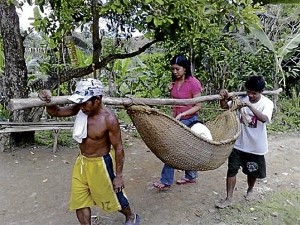
CINEMA VERITÉ is a category of film realism in vogue in the early ’60s popularized by French and American experimental film directors who used plain people shot with hand-held cameras. Their films project raw reality as the point of high involvement for the viewer.
GMA News channel 11’s series—“i-Witness,” “Front Row” and “Reel Time”—have been showing cinema verité documentaries on poverty which are veritable tearjerkers and conscience strikers. They are horrible grabbers. These documentaries force us to confront the lives of the poor in their most harrowing moments.
Kara David is unpretentious but surprisingly gung-ho when hosting cinema verité documentaries. She’s disarmingly all-natural on location, with none of the affectations and practiced accents common to local newscasters. Kara easily inhabits poor villages by blending quickly with the realities of deprivation, habitat and shyness common to the poor.
Her words are sparse, cryptic, just enough to draw out feelings and thoughts out of the tight-lipped and hesitant poor people. But her heart is big. With her occasional silence and sad eyes, she bonds well with the poor without asking difficult questions.
Kara is especially effective when caring for the hopelessly sick, helping them access medical treatment. She accompanies them to health centers located in some God-forsaken place. These ill-equipped, undermanned health outposts with a solitary doctor usually make do with insufficient supply of medicines. In one instance, Kara taught an illiterate man how to feed his malnourished child by demonstrating how to mix powdered milk in a baby bottle which she herself bought.
Rugged anthropologist
Surprise! The same caring Kara David becomes a rugged anthropologist tackling perilous stints. I’ve watched her crawl on all fours penetrating gold miner’s holes, foraging for gold dust. Kara hurdled half a kilometer of a one-meter circumference cave, tracking a little boy who helps his father hunt for gold inside the suffocating and mud-filled bowels of the earth.
A muddied-all-over Kara, sometimes gasping for breath, talking to the boy in short phrases is a shocking sight. At other times, Kara goes with crocodile hunters on a spooky, nocturnal hunt in the swampy wetlands of Palawan. Screaming, scared and amused, she helps rope those man-eating monsters to be tagged for census purposes. Her topic: endangered species.
The documentary by Jay Taruc on hunger is particularly riveting. Taruc is the master of tension. His plebeian personality blends well with the masang Pilipino’s defining moments. He is unobtrusive and a sincere participant in experiencing hunger every moment of the day, by living with the hungry poor in the smelly and dank subterranean world of Manila where the poor live like sewer rats.
Taruc stayed for several days with a grotesque, gaunt and sooty man who wore the bony face of death, and who tries his luck to be a kargador in the crowded alleys of Divisoria. His best gamble was to finagle P200 to buy the one miserable meal a day for him and his equally soiled children (with one small piece of food for Taruc as his share).
By nightfall, Taruc got hunger pains in the pit of his stomach and dizziness on his head. Life must go on. Taruc’s work on trash scavengers is equally riveting!
Mainstream media’s best portrayal of the poorest of the poor is tagged by social researchers as the “hunger barometer.” The statistics on grumbling stomachs (the highest at 23.8 percent as of March 2012) is just one aspect of poverty’s many reported miseries. We must add untimely predestined death (with zero-percent medical treatment), and infectious and organ diseases which are untreated.
These injustices have been inflicted by a democratic form of government such as ours, which has muddled through poor people’s welfare since we acquired self-rule and independence in 1946.
Cold numbers
Statistics on our poorest of the poor are cold numbers in the minds of our bureaucrats, upper-middle class, middle class and CD eco-class segments.
It’s a mistake to relegate the poorest of the poor to the category of the “marginalized” sector, resigning their existence to the harsh life in isolated, far-flung villages. This subhuman state of citizenship is a big indictment of the government’s incompetence and lack of compassion.
Channel 11’s strategy of using cinema verité in news gathering inspires its news crew to seek the more unexposed sociological view, at times anthropological, of our society. The hunt for breakthrough reporting allowed them to come up with news documentaries that break the rules of today’s news reporting stereotypes exemplified by hysterical early evening “tabloidist” newscasts.
Surprisingly, a lot of pathos and empathetic themes, enough to rival the mundane sentimentalism of telenovelas, are generated by channel 11’s cinema verité documentaries. It seems that the poorest of the poor have a terrific coping mechanism. Miserable yet endurable, resigned yet hopeful, deprived but peaceful.
“I-Witness,” “Front Row” and “Reel Time” are channel 11’s program slots for the outstanding works of Kara David and Jay Taruc. Both are winners of the George Foster Peabody award in the New York Film Festival.
David and Taruc are iconic brand names (Randy David of the Inquirer and Joe Taruc of DZRH) in insightful public communications. It can be a case of like father, like daughter, and like father, like son.
The intensely arresting educational documentaries of channel 11 have the impact to unite viewers into pressuring our government to apply forceful political will to fight poverty in manageable and critical prioritized units. The successful unit must be market-tested, and can be rolled out nationwide. No pallative tokens.
E-mail: hgordonez@gmail.com